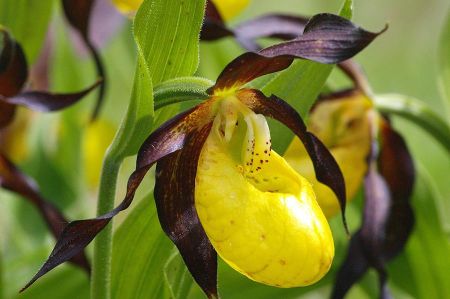A destination: Lechtal when the lady's slipper is blooming
- Written by Portal Editor
It will soon be that time again, because then lovers of nature and especially friends of the lady's slipper will be drawn to the Tyrolean Lech Valley, because the Lech flows through the valley in the most beautiful turquoise nuances.
Sometimes stormy, sometimes gentle, because the Lech doesn't like to be dammed and certainly not confined to its riverbed. The Lech is wild and free and it shapes the people who live in its valley, on its banks or hike through the valley because there is something else very special. As readers of the alaturka portal, we take you on a fascinating journey through pristine nature and an incomparably beautiful habitat that needs to be preserved: That means - don't touch it or even dig it up. And when taking photos, please use the telephoto lens!
Hundreds of visitors come to see the lady's slipper flower
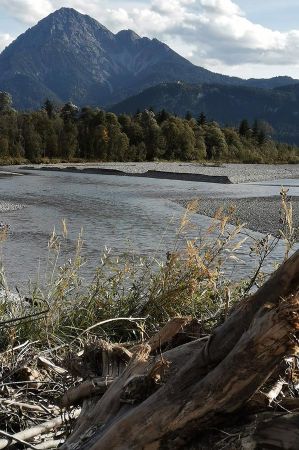 Every year in late spring between mid-May and mid-June, admirers are captivated by the lady's slipper blossom in the Lechtal. Although there are other regions that are particularly attractive when it comes to orchid blossoms, the Lechtal has something of its own, because as one of the most magnificent wild orchid species in Europe, especially in the wildly romantic Lechtal, the predominantly yellow lady's slipper takes the hearts of its visitors by storm.
Every year in late spring between mid-May and mid-June, admirers are captivated by the lady's slipper blossom in the Lechtal. Although there are other regions that are particularly attractive when it comes to orchid blossoms, the Lechtal has something of its own, because as one of the most magnificent wild orchid species in Europe, especially in the wildly romantic Lechtal, the predominantly yellow lady's slipper takes the hearts of its visitors by storm.
As a plant with special demands on its habitat, the lady's slipper is protected throughout Europe. In the European Union's Flora-Fauna-Habitat Directive it is included in the list of so-called priority species for which special protective measures must be taken. While in the past the digging up of plants by collectors and traders was a major threat factor, today the lady's slipper suffers primarily from shading caused by increasingly dense forests and the abandonment of traditional forms of forest use.
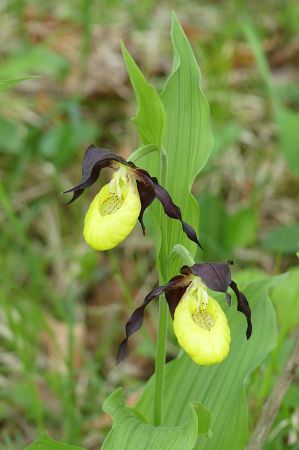 The yellow lady's slipper grows primarily in sparse forests and prefers calcareous soils. Germany is also in the main distribution area of the species, which extends across large parts of Europe and Asia. There are around 50 other species of lady's slippers worldwide. In the nationwide red list, it is classified as “endangered” (category 3) nationwide, but regionally the risk is often significantly greater. The largest deposits are still in the alpine and low mountain regions of Bavaria, Baden-Württemberg, Hesse, Thuringia and Lower Saxony.
The yellow lady's slipper grows primarily in sparse forests and prefers calcareous soils. Germany is also in the main distribution area of the species, which extends across large parts of Europe and Asia. There are around 50 other species of lady's slippers worldwide. In the nationwide red list, it is classified as “endangered” (category 3) nationwide, but regionally the risk is often significantly greater. The largest deposits are still in the alpine and low mountain regions of Bavaria, Baden-Württemberg, Hesse, Thuringia and Lower Saxony.
Lady's slippers grow up to 60 centimetres high and bloom in May and June. The so-called shoe that gives it its name is the slipper-shaped front part of the flower, which serves as a kind of trap for insects. A thin film of oil on the edges ensures that attracted insects have difficulty finding a grip and slide into the inside of the shoe. The only safe way out is past the flower scar, so that the plant automatically pollinates as you walk past.
The best protection for the yellow lady's slipper
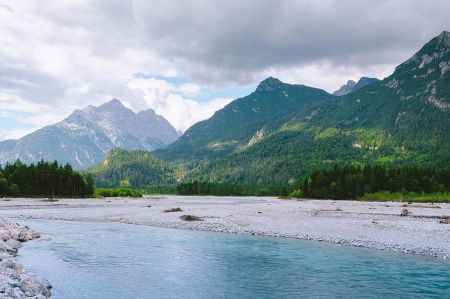 We can help the beautiful orchid, and it often depends on farmers and foresters whether and how the populations of the yellow lady's slipper can develop. Here are some basic tips on how to avoid damage or even improve the orchid's habitat:
We can help the beautiful orchid, and it often depends on farmers and foresters whether and how the populations of the yellow lady's slipper can develop. Here are some basic tips on how to avoid damage or even improve the orchid's habitat:
- Promote light forest forms, for example mixed forests with trees of different ages and also some conifers
- Preserve and promote old forms of forest use (e.g. coppice management).
- If necessary, improve the light available for lady's slipper populations, for example by removing individual trees
- Promote and maintain wide forest edges of 30 to 40 meters wide
- Only use forests with women's slippers carefully and without heavy machinery
- If felling is unavoidable at a place of growth, under no circumstances should the orchids be completely exposed; Completely remove branches and clippings
- Windthrow areas that are not reforested can develop into new lady's slipper habitats
- Improve conditions for pollinators (especially sand bees) near lady's slipper populations. Suitable nesting places for sand bees include poor grassland, borders or open, south-facing sandy areas
- Do not mow roadsides in summer so that wild bees living in the forest can find enough food
- Do not use fungicides in the forest (mycorrhizal fungi!)
- Protect open habitats from bush encroachment, for example through extensive grazing
Living conditions, like those for many species, are deteriorating
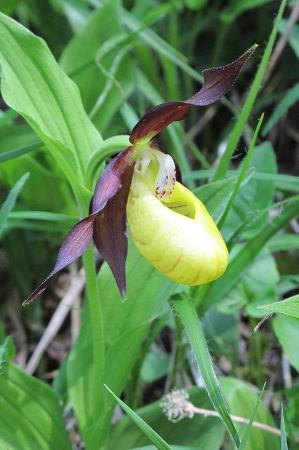 Unfortunately, living conditions for the yellow lady's slipper have deteriorated significantly in many places. Near-natural forests have become rare, traditional forms of forest use are being abandoned and forestry and agriculture are being intensified, because a certain amount of light is vital for the lady's slipper.
Unfortunately, living conditions for the yellow lady's slipper have deteriorated significantly in many places. Near-natural forests have become rare, traditional forms of forest use are being abandoned and forestry and agriculture are being intensified, because a certain amount of light is vital for the lady's slipper.
In locations where, for example, light forests have been converted into dark spruce forests due to intensification of forestry or where limestone grasslands have become overgrown, the plant has a bad hand. If it no longer receives enough light, the partial shade-loving orchid will no longer produce flowers.
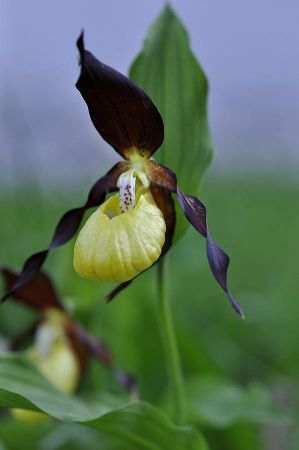 In addition to the ecological problems mentioned, the stocks suffer from so-called orchid tourism. Because you are not alone when you visit one of the locations of the yellow lady's slipper when it is in bloom. Known deposits are visited by crowds during the high season year after year. “Flower lovers” dig up plants or “hunt” for the best possible photo with their cameras.
In addition to the ecological problems mentioned, the stocks suffer from so-called orchid tourism. Because you are not alone when you visit one of the locations of the yellow lady's slipper when it is in bloom. Known deposits are visited by crowds during the high season year after year. “Flower lovers” dig up plants or “hunt” for the best possible photo with their cameras.
In doing so, they crush neighbouring plants or – even worse – compact the soil around the orchids. So it's no wonder that important deposits in some places are guarded by conservationists during their heyday or that locations are kept secret from the general public.
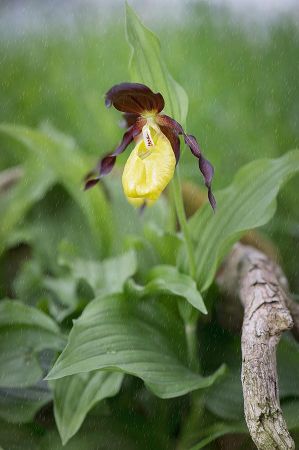 Picking or digging in particular threatens the sought-after orchid in many locations. The collecting mania of some plant lovers is not only selfish and illegal, but also completely pointless. The yellow lady's slipper depends on a very specific root fungus, a mycorrhizal fungus of the genus Rhizoctonia. This only occurs in forests where conifers also grow. This means they cannot germinate in gardens. So next spring the splendour will be over. Bad luck for the hobby gardener - but especially for the orchid.
Picking or digging in particular threatens the sought-after orchid in many locations. The collecting mania of some plant lovers is not only selfish and illegal, but also completely pointless. The yellow lady's slipper depends on a very specific root fungus, a mycorrhizal fungus of the genus Rhizoctonia. This only occurs in forests where conifers also grow. This means they cannot germinate in gardens. So next spring the splendour will be over. Bad luck for the hobby gardener - but especially for the orchid.
Please read as well:
